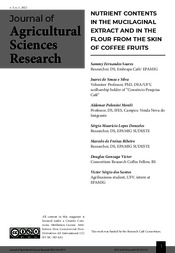Nutrient contents in the mucilaginal extract and in the flour from the skin of coffee fruits.
Nutrient contents in the mucilaginal extract and in the flour from the skin of coffee fruits.
Author(s): SOARES, S. F.; SILVA, J. de S. e; MORELI, A. P.; DONZELES, S. M. L.; RIBEIRO, M. de F.; VICTOR, D. G.; SANTOS, V. S. dos
Summary: The processing of coffee fruits in order to obtain peeled cherry coffee generates residues such as the husk, which is used in fertilization and animal feed, and the mucilage, which comes out with the wastewater. The objective of this work was to determine the nutrient content in the mucilaginous extract and in the peel flour of coffee fruits of the Oeiras, Catiguá and Catuaí Vermelho varieties. The coffee fruits were washed in potable water and peeled, without using water in the peeler. The peeled cherry coffee was placed in a plastic tray with enough water to cover the beans and, the next day, the coffee was sieved and the mucilaginous extract was separated. The bark was dried in an oven with forced ventilation and then ground. Samples of the mucilaginous extract and the flour from the peel of the fruits were analyzed in the laboratory, according to the usual methods for analyzing effluents and food. The levels of K, Ca, Mg and Na, determined in the mucilaginous extract of the Oeiras, Catiguá and Catuaí Vermelho varieties ranged from 662 to 3307, 154 to 317, 60 to 114 and 12 to 108 mg.L-1. The protein contents, carbohydrate, fiber, fat and K in the flour of the Oeiras and Catiguá varieties were 9 and 8, 65 and 68, 19 and 12, 1 and 0.8, and 2700 and 5150 g/100g, respectively. The mucilaginous extract and flour from the coffee fruit peel can be used by the industry to manufacture various products.
Publication year: 2022
Types of publication: Journal article
Unit: Embrapa Coffee
Keywords: Coffee beans, Fruit peels, Nutrients
Observation
Some of Embrapa's publications are published as ePub files. To read them, use or download one of the following free software options to your computer or mobile device. Android: Google Play Books; IOS: iBooks; Windows and Linux: Calibre.
Access other publications
Access the Agricultural Research Database (BDPA) to consult Embrapa's full library collection and records.
Visit Embrapa Bookstore to purchase books and other publications sold by Embrapa.

